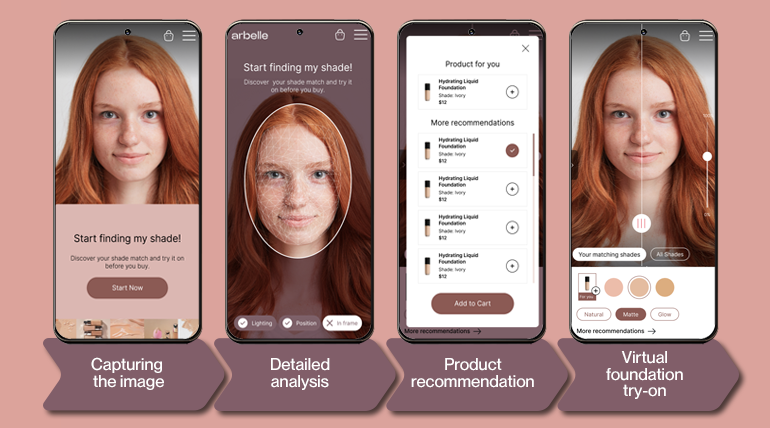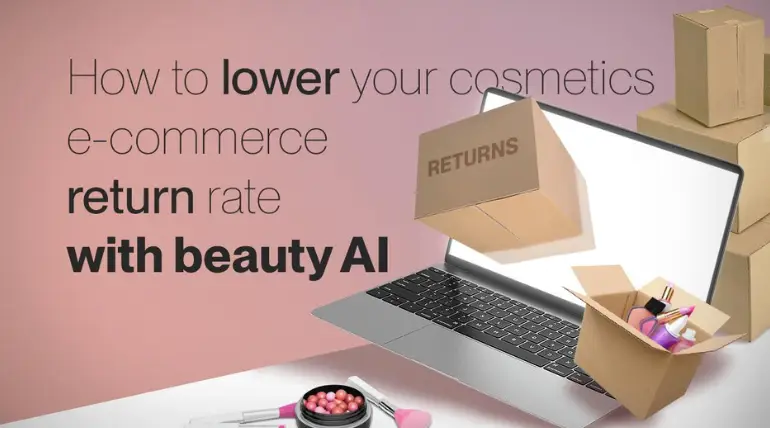In today’s digital era, the cosmetics industry has witnessed a significant shift toward e-commerce. For example, more than a quarter of L’Oréal’s total sales in 2022 (28% to be precise) was generated through e-commerce.
However, this shift brings its own set of challenges, particularly in managing the e-commerce return rate.
And with this in mind, understanding the dynamics of returns and leveraging technology like beauty AI can be transformative.
So, in this article, we’ll explore how beauty AI solutions, such as virtual try-ons, can help reduce your e-commerce return rates.
E-commerce returns statistics: An overview
➥ Current return rates and trends
The cosmetics e-commerce sector has seen a steady increase in sales, yet this growth is accompanied by a dynamic shift in return rates.
- According to The National Retail Federation, the approximate cost of online returns in 2022 reached $212 billion, doubling since 2020.
- And if we look at the online return rates across sectors, they amounted to 16.5% in 2022 in the U.S. Which means that they more than doubled since 2019, when they were 8.1%.
But let’s look at the beauty and cosmetics sectors specifically:
❖ While the global e-commerce return rate in the beauty and cosmetics industry stood at around 4% in 2020, recent findings by Statista (2022-2023) show it increasing to approximately 10% for cosmetics. At first glance, these figures may not seem that high. But what we should remember and consider is that there are usually restrictions on what products can be returned in this sector.
These figures, while seemingly moderate, are significant within the context of the global cosmetics e-commerce landscape. Why? Because high return rates impact not only revenue, but also operational costs and the environment.
➥ The impact of returns on cosmetics e-commerce businesses
Generally, businesses incur additional costs for processing returns, restocking, and potentially discarding returned products. This cycle is not only financially draining but also damages brand reputation over time.
Moreover, another research reveals that as many as 67% of customers scrutinize an online store’s return policy before making a purchase. And this implicitly suggests they’re anticipating potential dissatisfaction or a product mismatch.
This growing trend underscores the importance of innovative solutions like virtual try-ons. Why? Because in this era of online shopping, aligning customer expectations with product realities has never been more important. But a bit more on that later.
First, let’s see some of the most common reasons why customers return products in the first place.
Common reasons for e-commerce returns in the beauty industry
The reasons for returns in the cosmetics industry are varied, ranging from impulsive shopping to product quality issues. It’s important to emphasize that they may differ from company to company, so it’s always best to conduct some internal research to get to the bottom of it.

But there are some reasons that stand out the most and are at the heart of it all. These include:
| 1. Impulsive shopping: A significant factor in e-commerce returns is impulsive buying. Data from Psychology Today suggests that impulsive purchases, often driven by emotional triggers or promotional tactics, account for a substantial portion of online shopping behavior. However, once the initial excitement wanes, customers may regret their decision, leading to a higher likelihood of returns. |
| 2. False expectations: The discrepancy between online product images/descriptions and the actual product is a major issue. According to a recent study, 64% of returns are due to the product looking different in person. This misalignment creates a gap between customer expectations and reality, often resulting in dissatisfaction and returns. |
| 3. Poor quality products: The quality of products plays a crucial role in customer satisfaction. In the beauty industry, where product efficacy and safety are paramount, any deviation from quality standards can lead to immediate returns. |
| 4. Close to expiration date: Products nearing their expiration date are less appealing to customers, primarily due to reduced efficacy and potential safety concerns. Customers are increasingly aware and cautious of product shelf life, making this a notable reason for returns. |
| 5. Returning a gift: Gift returns are common in e-commerce, particularly in the beauty sector. The personal nature of cosmetics means that gifts may not always align with the recipient’s preferences or needs, leading to higher return rates in this category. |
Understanding these diverse causes is essential for businesses, especially in the cosmetics industry. Based on them, among other factors, you can tailor your strategies such as incorporating AI and virtual try-on technologies, to effectively reduce return rates and enhance customer satisfaction.
Strategies for reducing online returns in the cosmetics industry
Arbelle, an advanced beauty AR solution, offers a revolutionary way to tackle the high e-commerce return rate. By incorporating virtual try-on, Arbelle addresses many of the core reasons for returns. Here’s how.
1. Virtual try-on technology
Arbelle’s virtual try-on technology revolutionizes the online cosmetics shopping experience. By leveraging advanced AR, customers can see how products look on their skin in real time using their smartphone or computer camera.
This immersive experience goes beyond traditional product images, providing a realistic and personalized preview. For example, customers can see how a particular shade of lipstick or foundation matches their skin tone before purchasing, significantly reducing the discrepancy between online expectations and the actual product.
This not only boosts customer confidence in their purchase decisions but also dramatically lowers the likelihood of returns due to dissatisfaction.

➥ READ MORE: How to leverage beauty AR & AI in e-commerce
2. Personalized product recommendations
Arbelle’s integration of data analytics personalizes the shopping journey, making it more than just a transactional experience.
By analyzing customer data such as previous purchases, skin type, color preferences, facial features, or specific demographics, you can also provide your customers with tailored product recommendations. This targeted approach helps them navigate the vast array of products and find those that truly meet their needs and preferences.
For example, a virtual shade finder can detect your customers’ skin tone and based on it, suggest ideal products.

This informed and personalized shopping experience not only elevates customer satisfaction but also strategically reduces impulsive purchases, which are often the primary drivers of high return rates.
3. Quality assurance
Arbelle’s approach to showcasing products realistically and interactively plays a pivotal role in assuring customers of the quality and compatibility of products. Through high-resolution, accurate color rendering, and detailed product descriptions, customers get a true-to-life representation of products.
This transparency is crucial in an industry where the nuances of product texture, color, and application are vital. For instance, when customers can see the texture or the finish of a foundation or lipstick through Arbelle’s realistic representation, their confidence in the product’s quality increases. This then reduces the likelihood of returns due to unmet quality expectations.
In the realm of e-commerce, where physical product interaction is absent, this level of quality assurance is invaluable.
All in all, Arbelle’s technology isn’t just about reducing return rates; it’s about transforming the entire shopping experience. It fosters a sense of confidence in customers, ensuring that what they see online is what they get. This alignment significantly lowers the chances of returns due to dissatisfaction or unmet expectations.
Start minimizing your e-commerce returns today
The integration of beauty AI and AR solutions like Arbelle into the e-commerce framework of the cosmetics industry is more than a trend—it’s a necessity.
By addressing the root causes of high return rates, Arbelle not only enhances customer satisfaction but also boosts the operational efficiency and profitability of businesses.
So, in an age where digital presence is paramount, leveraging such innovative solutions is key to staying ahead in the competitive landscape of cosmetics e-commerce.
Don’t hesitate to get in touch with us and we’ll help you get started.
Get started with Arbelle
Contact us today and we’ll help you create the optimal beauty AR experience for your e-commerce business.

